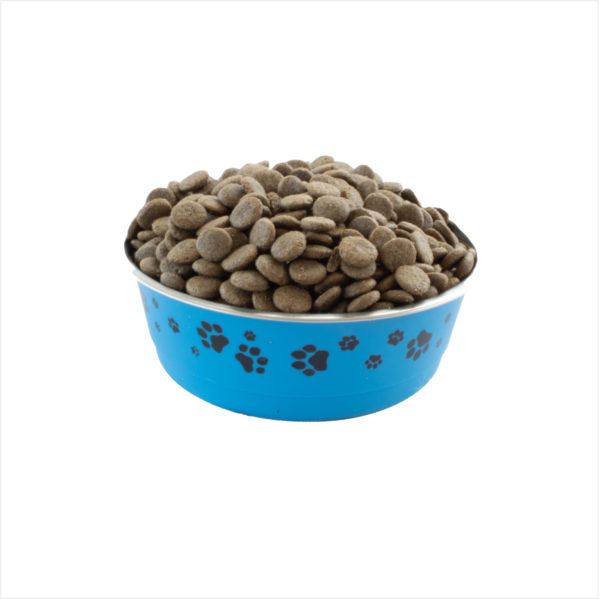If your dog has a particularly sensitive stomach, regular dog food might not be the best thing to feed your pet.
Many brands have specially formulated dog foods for canines with less robust digestive systems — Angell PetCo included. Our line of Superior Sensitive Complete is designed to be gentle on the stomach with a careful blend of high quality white fish and chicken.
Read on to find out how to spot your dog’s sensitivities, as well as how to treat them.
Signs Your Dog Has a Sensitive Stomach
If your dog has a sensitive stomach, you’ll no doubt know about it.
There are some classic signs that your dog is experiencing digestive problems. These include vomiting, loose stools and flatulence. More subtle symptoms like loss of appetite, hypersalivation and consistent swallowing, indicating nausea could appear over time.
Your dog may have had sensitivities since puppyhood. Yet, adult dogs can also develop sensitive stomachs as they age or as a result of a change in diet. Certain breeds of dog are more prone to stomach sensitivities like Pugs. Most dogs will experience some minor digestive problems at some point in their life. Usually, digestive issues don’t require veterinary attention unless symptoms are sustained or worsen quickly.
It’s more likely you’ll need to focus on your dog’s diet to relieve digestive discomfort.
However, if your dog shows signs of serious illness like the appearance of blood in stools and decreased mobility, don’t hesitate to get in touch with your vet for further guidance.
What Is the Easiest Food for a Dog to Digest?
A dog’s digestive system is different from ours with a much slower rate from consumption to release. On average, dogs take around eight to ten hours to digest a single meal, meaning even the most healthy dogs only need two meals per day.
Whichever food you decide to feed to your dog, make sure you’re not dishing out meals too regularly. While the portion size should change, depending on the size of your dog, the frequency of meals should stay the same with one meal in the morning and one in the evening giving plenty of time in between to complete digestion.
Be it a Yorkshire Terrier or a Great Dane, the two meals per day rule applies.
When choosing a food staple, always opt for dry food — also known as kibble. This texture helps to soak up any acids in the stomach and stops loose stools and the sensations of nausea after eating.
Kibble should always be accompanied by plenty of fresh water.
When it comes to the ingredients contained in sensitive stomach dog food, the list usually steers away from foods that could cause indigestion as well as any items that are too rich. Sensitive stomach dog food tends to be bland — but it doesn’t have to be boring.
Here are some of the easiest foods for a dog to digest:
- Whitefish
- Unseasoned Chicken
- Potato
- Salmon Oil
- Rice
- Sweet Potato Peas
The above is basically a summary of our sensitive stomach dog food formula.
A blend of both chicken and fish — in our sensitive stomach dog food’s case, trout and whitefish — gives your dog a generous portion of protein, without clogging up the intestinal tract or ramping up the fat content.
Mixing rice, sweet potato and potato gives our sensitive stomach dog food plenty of substance, fuelling your dog’s day with essential carbohydrates and fibre.
The addition of salmon oil helps to make the mixture anti-inflammatory. It also works wonders for your dog’s coat.
Finally, peas — along with other minerals and vitamins — are added to ensure this formula is full of micronutrients.
Shop our Superior Sensitive Complete kibble now.
Puppies with sensitive stomachs should also have a similar food composition — but puppy food needs to be higher in fat due to the fast growth rate of young dogs.
For this reason, lean meat like chicken might be swapped out for fresh salmon to increase the amount of omega-3 fatty acids in the blend.
This is why our puppy food range includes a blend of salmon, haddock and blue whiting, as well as an additional omega-3 supplement.
Shop our Superior Puppy Complete now.
What to Remove from Your Dog’s Diet
If you suspect your dog has a sensitive stomach, the first thing you should do is strip back your feeding schedule.
In the long-run, your main meal food blend may have to change to a more stomach-friendly kibble, but in the short-term, you should work to eliminate any scraps you’re guilty of giving your dog, as well as any unnecessary snacks and treats.
This isn’t about punishing your dog or removing any joy from your pet’s play. Eventually, you should be able to replace dental chews, unhealthy training treats and midday snacks with natural alternatives. But to be kind to your dog and remove their potentially painful symptoms, less is always more.
Secondly, make sure your dog isn’t accessing food without you knowing about it.
If your kitchen or outdoor bins are easy to access, you might consider moving or securing them to make sure there’s no way your dog could rummage around in any leftovers. Also, try to discourage any behaviours like eating grass and attempts to gobble strewn food and litter on walks as these things can cause dogs to vomit.
At this point, you’ll be left with the bare basics to access.
If your dog’s kibble is still causing your dog to experience sensitive stomach symptoms, you may want to consider the following:
- Swapping your protein source to a meatless alternative. Fish is a gentler protein source for dogs with a sensitive stomach and in some cases, dogs can be allergic to protein sources like beef.
- Consider wheat-free food. Some grains cause allergic reactions in many dogs, such as wheat. Instead, opt for foods with a small portion of gentle grains like rice that’s low in fat, easy-to-digest and can help stools to bind.
- Check fat content. Some popular pet food brands contain a long list of ingredients that can cause the fat content of such formulas to creep up. Although dogs need healthy sources of fat, they shouldn’t have too much as this can meddle with their digestive system and eventually lead to pancreatitis and a plethora of heart conditions.
- Scrutinise ingredient quality. Make sure that your pet food is made of fresh human-grade food that doesn’t include any byproducts or food derivatives. Good quality foods should contain good quality ingredients that are cooked using a gentle cooking process to preserve natural goodness.
- Buy from natural brands. All dogs should eat food made from high-quality ingredients with zero non-nutritional fillers, artificial additives, preservatives and flavouring. The impact of sub-par dog food can be seen far earlier in dogs with sensitive stomachs.
- Cook bland foods. For immediate relief, you might consider home-cooked meals with zero seasonings. For example, a simple meal of turkey and rice may allow your dog’s stomach to settle before you can buy specialist sensitive food from a store or website. Although this option isn’t sustainable for the long-term, it does give you a quick solution for recurring stomach problems.
Find a long-term solution for your dog’s sensitive stomach. Always stay stocked up on Superior Sensitive Complete. This all-natural, stomach-settling blend can be bought with delayed, interest-free payments on bulk buys of bags up to 240kg. You can buy any of our products on a subscription basis and always receive free UK delivery as standard.




